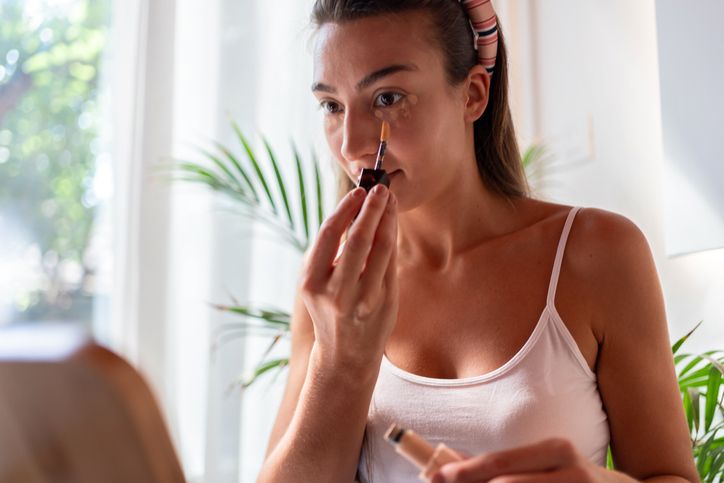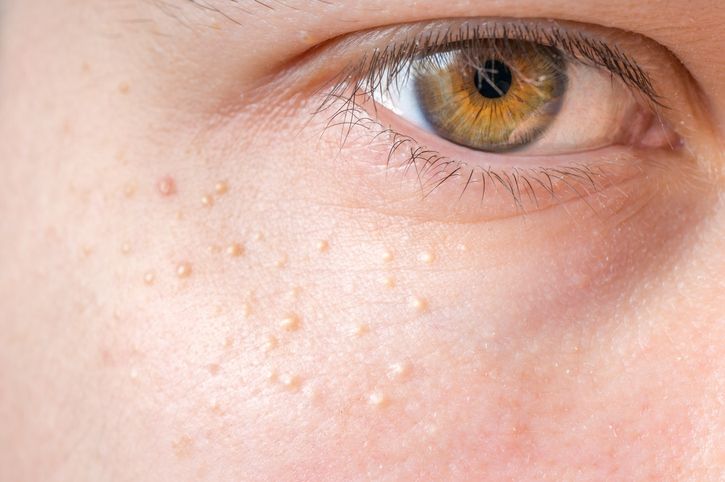- Home
- Trend
- Weight Loss Strategies
- Acne Tips
- Hair Health Information
- Blemish Removal Tips
- Acne Scar Removal Tips
- Muscle Building Techniques
- Intimate Care Tips
- Postpartum Intimate Care
- Eye Bags Wiki
- Tips for Face Slimming
- Secret of Permanent Hair Removal
- Breast Enlargement Tips
- Cure to Snoring
- Marionette Lines
- Skin-Tightening Secrets
The hairline – a frame for the face, and sometimes, a source of concern. If you've noticed your hairline gradually receding, forming a distinct "M" shape at the temples, you might be experiencing male pattern baldness (androgenetic alopecia). But fear not, gentlemen (and some ladies too), for this blog delves into the reasons behind M-shaped hairlines and explores solutions to restore a natural, youthful appearance.
Understanding the "M": A Matter of Genetics and Hormones
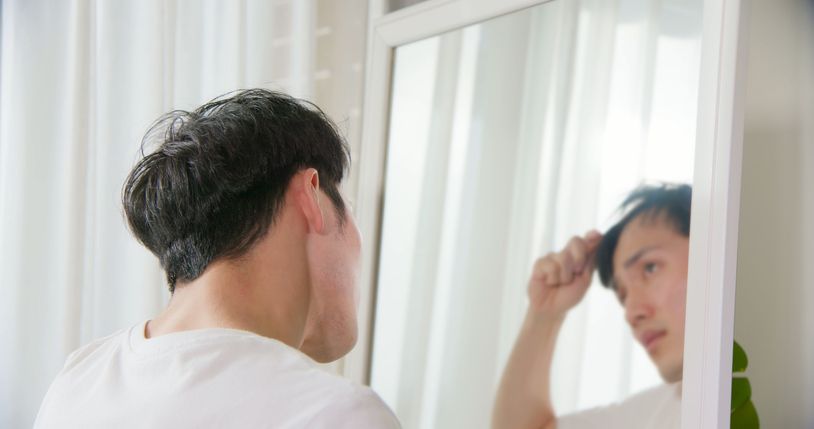
Androgenetic alopecia, often referred to as male or female pattern baldness, is the most prevalent form of hair loss, impacting millions globally. This condition is distinguished by a progressive thinning of hair that typically begins with a receding hairline, forming the characteristic "M" shape.
The "M" pattern of hair loss is most commonly observed in men, where the hairline recedes at the temples, creating the distinctive shape. In women, androgenetic alopecia usually presents as a general thinning across the crown, rather than a defined receding hairline.
Early Indicators of Androgenetic Alopecia
- Temporal Hairline Recession
One of the initial signs of androgenetic alopecia is a gradual recession of the hairline at the temples. This recession typically starts subtly on one or both sides of the forehead and progresses upwards. Men often notice a distinct "M" shape forming at the front of their hairline, where the hair recedes at the temples, creating a characteristic pattern that is indicative of this condition.
- Decreased Hair Density
As androgenetic alopecia progresses, people may observe a decline in hair density, particularly noticeable in the frontal scalp (forehead region) and at the vertex (crown of the head). This decrease in hair density can make the scalp more visible and is often accompanied by increased hair shedding. Men may notice more hair strands falling out during showers or while brushing, despite not immediately noticing significant overall hair loss.
- Widening Parting Line
Another early indicator is the widening of the natural parting line in the hair. The parting line, where the hair naturally separates when falling freely, may become wider and more pronounced. This widening occurs as the hair on either side of the parting line thins out due to the miniaturisation of hair follicles. As a result, the scalp becomes more visible through the hair, especially under certain lighting conditions.
Differences Between Mature Hairline and M Shape Hairline

Hairlines, much like our fingerprints, are all unique. But as men age, things can shift eventually. Sometimes, this can lead to a bit of confusion between a mature hairline (totally normal) and a receding hairline (potential hair loss). Here's the breakdown to help you figure out what's going on with your hair:
Mature Hairline
• Appearance: A mature hairline typically presents as a smooth, gently receding hairline across the forehead. It may have a slightly rounded or pointed shape at the temples, sometimes referred to as a "widow's peak."
• Recession Level: The overall hairline recedes slightly from its original juvenile position, typically by no more than 1-2 cm (0.4-0.8 inches).
• Hair Loss: This is not necessarily a sign of hair loss, but rather a natural part of the ageing process for many men. There is minimal to no thinning of hair at the temples or scalp.
• Impact on Hair Density: Hair density generally remains consistent throughout the scalp, with no significant loss of hair volume.
M-Shaped Hairline (Receding Hairline)
• Appearance: An M-shaped hairline recedes noticeably in a distinct "M" pattern at the temples. The temples become noticeably higher and the hairline may form sharp corners or points at the receding areas.
• Recession Level: Receding hairlines typically progress further back from the original hairline, potentially exceeding 2 cm (0.8 inches).
• Hair Loss: This is a sign of hair loss, often associated with male pattern baldness (MPB). Thinning of hair often accompanies the receding hairline, and may progress to complete baldness in the affected areas over time.
• Impact on Hair Density: Hair density may decrease in the receding areas, with thinning and potentially visible scalp showing through.
免費體驗
F8 Hair Regrowth Treatment
1 Minute Self-Registration
Date should not be before minimal date
What Causes This M-Shaped Hairline?
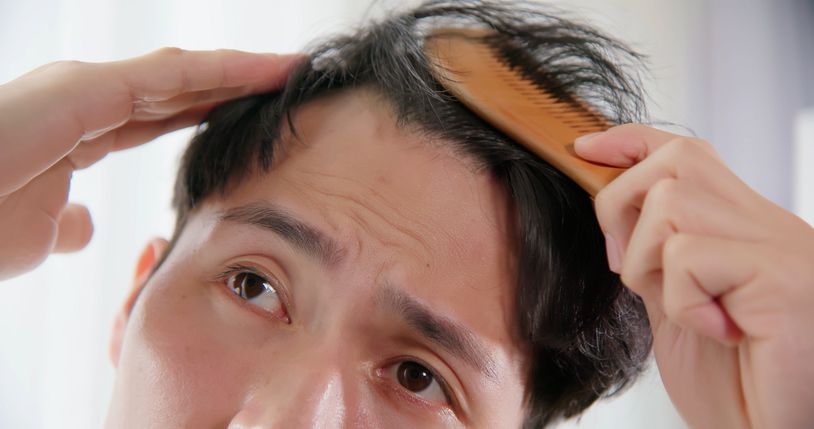
Male pattern hair loss or female pattern baldness, progresses through distinct stages as the condition advances. The rate at which androgenetic alopecia progresses can vary significantly among individuals. Some individuals may experience rapid hair loss, where noticeable changes occur within a few months or years.
In contrast, others may undergo a slower, more gradual thinning process that spans over decades. Several factors can exacerbate the development of an "M" shaped hairline, which is characteristic of androgenetic alopecia (male pattern baldness). These include:
1. Genetics: Family history plays a significant role in the onset and progression of androgenetic alopecia. If there is a history of male pattern baldness in your family, you are more likely to develop an "M" shaped hairline.
2. Hormones: Androgenetic alopecia is influenced by hormones, particularly dihydrotestosterone (DHT), which is derived from testosterone. DHT shrinks hair follicles in susceptible individuals, leading to hair thinning and the characteristic "M" shaped pattern.
3. Age: The likelihood of developing an "M" shaped hairline increases with age, as hair follicles become more sensitive to hormonal changes over time.
4. Stress: Chronic stress can contribute to hair loss by disrupting the hair growth cycle. Stress hormones may affect hair follicles, leading to increased shedding and accelerated hair thinning.
5. Poor Scalp Health: Scalp conditions such as dandruff or scalp inflammation (dermatitis) can compromise hair follicle health, potentially accelerating hair loss and the formation of an "M" shaped hairline.
6. Unhealthy Lifestyle: Factors such as smoking, excessive alcohol consumption, and poor nutrition can negatively impact overall hair health and contribute to accelerated hair loss.
7. Medical Conditions: Certain medical conditions and treatments, such as autoimmune disorders, thyroid disorders, and chemotherapy, can cause hair loss or exacerbate existing hair thinning patterns.
8. Environmental Factors: Exposure to pollutants, UV radiation, and harsh chemicals in hair care products can damage hair follicles and contribute to hair loss.
Importance of Early Detection: Preserving Your Hairline
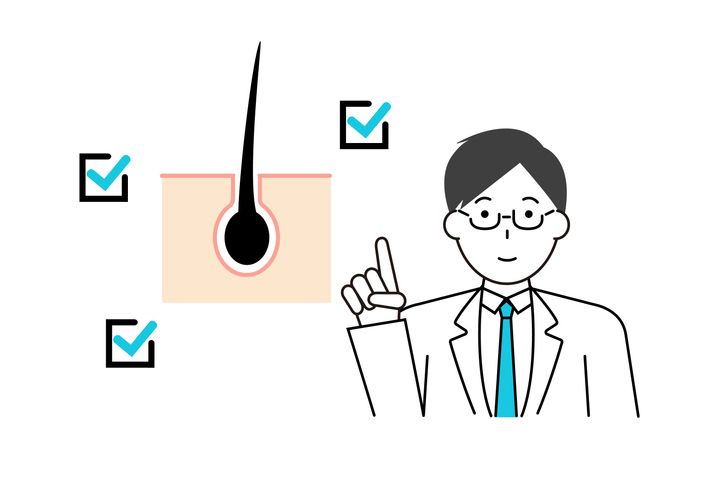
Early detection plays a crucial role in managing androgenetic alopecia effectively. Recognizing the initial signs of hair thinning allows men to take proactive steps with the guidance of healthcare professionals, potentially slowing down hair loss and preserving a fuller head of hair for longer.
1. Recognizing Early Signs
Androgenetic alopecia often begins subtly, with signs such as a gradual thinning of hair at the temples or a receding hairline in an "M" shape pattern. Other indicators include increased shedding during grooming or noticeable changes in hair density on the scalp. By paying attention to these early cues, men can seek timely evaluation and intervention.
2. Consultation with Haircare Professionals
Seeking guidance from healthcare professionals, such as dermatologists or hair specialists, is crucial for accurate diagnosis and personalised treatment planning. These experts can conduct a thorough scalp examination, evaluate medical history, and assess genetic factors contributing to hair loss.
3. Exploring Treatment Options
Early detection empowers individuals to explore a range of treatment options tailored to their specific needs. This may include FDA-approved medications like minoxidil or finasteride, which help inhibit further hair loss and promote hair regrowth. Additionally, advanced treatments such as low-energy laser therapies or hair transplantation techniques can be considered for more significant restoration.
4. Slowing Hair Loss Progression
Taking action early can significantly impact the progression of androgenetic alopecia. Treatment interventions initiated during the early stages of hair thinning are more likely to yield positive outcomes by preserving existing hair follicles and maintaining overall hair density.
5. Enhancing Quality of Life
Beyond aesthetic concerns, addressing hair loss early can enhance quality of life and self-esteem. Maintaining a fuller head of hair allows individuals to feel more confident in their appearance and daily interactions, supporting overall well-being.
免費體驗
F8 Hair Regrowth Treatment
1 Minute Self-Registration
Date should not be before minimal date
Combating the M-Shaped Retreat: Strategies for Keeping A Polished Appearance
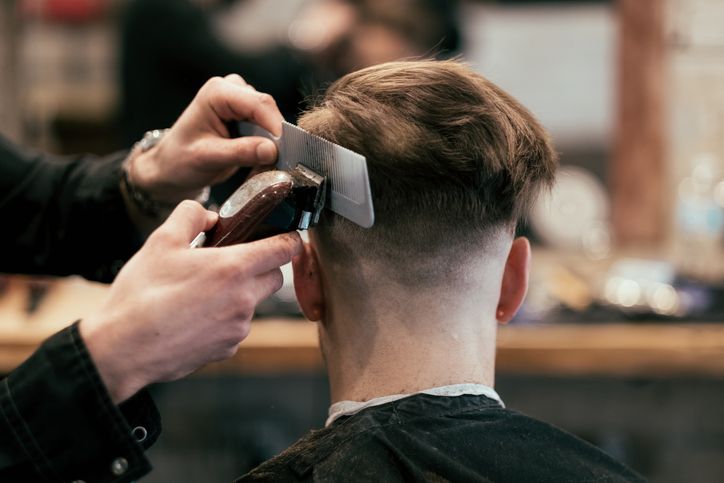
While male pattern baldness (MPB) can lead to a receding hairline, particularly in the M-shape, there's no need to accept a diminished head of hair. Fortunately, effective strategies exist to combat this hair loss and promote regrowth, restoring a fuller and more confident look:
1. Strategic Haircuts
Choosing the right haircut can significantly camouflage an M-shaped hairline. Consider styles that allow for some hair movement and coverage across the forehead. Here are some options:
• Side Swept: This versatile style parts your hair on one side and sweeps it across the forehead, effectively covering some of the receding areas.
• Textured Quiff: This style adds volume and texture to the top of your hair, drawing attention away from the hairline.
• Crew Cut: A shorter haircut minimises the visible scalp area and can be a good option if the hair loss is significant.
• Fringe/Bangs: A fringe or bangs can effectively cover the forehead and receding hairline. However, this style requires regular maintenance to keep the hair looking its best.
How you style your hair can also make a difference:
• Blow Drying: Blow drying your hair upwards and forward can create volume and coverage at the hairline.
• Hair Products: Using volumizing mousses or thickening sprays can add body and texture to the hair, making the hairline appear less noticeable.
2. Medical Treatments
For those who decided to fix an M shaped hairline, topical treatment like finasteride works by blocking the conversion of testosterone to DHT (dihydrotestosterone), a hormone that contributes to hair loss in men with MPB. Finasteride has been clinically proven to slow down hair loss and, in some cases, even stimulate new hair growth.
On the other hand, Minoxidil works by increasing blood flow to the scalp and promoting hair follicle activity. This can lead to a thickening of existing hair and, potentially, the growth of new hair. While typically used topically as a liquid or foam, Minoxidil can also be available in oral formulations.
It's important to note that both Finasteride and Minoxidil require consistent use to see results, and they may not be effective for everyone. Additionally, these medications can have side effects, so consulting with a doctor or dermatologist is crucial before starting treatment.
3. Hair Transplant Surgery
For a more permanent solution, hair transplantation offers a natural-looking and effective way to address M-shaped hairlines. This minimally invasive surgical procedure involves harvesting healthy hair follicles from a donor area on the scalp, typically the back or sides of the head, and transplanting them into the balding areas of the M-shape. There are two main techniques used in hair transplant surgery:
- FUT (Follicular Unit Transplantation)
This traditional method involves removing a strip of scalp from the donor area, dividing it into individual follicular units, and then transplanting these units into the recipient area.
- FUE (Follicular Unit Extraction)
A more advanced technique, FUE involves extracting individual follicular units directly from the donor area with minimal scarring. The extracted follicles are then transplanted into the balding areas.
Hair transplantation surgery offers long-lasting results, but it's important to consult with a qualified and experienced surgeon to discuss your candidacy and ensure a natural-looking outcome.
Perfect Medical: Your Partner in Restoring Natural Hairline
Hair loss, particularly the distinctive 'M-shaped' hairline associated with androgenetic alopecia, can profoundly impact self-confidence and appearance. Traditionally, methods have mostly been surgical. However, at Perfect Medical, we specialise in advanced and non-ablative hair restoration solutions tailored to effectively address such concerns
At the beginning of your visit, we start with a thorough consultation to accurately diagnose the cause of your M-shaped hairline. Our experienced hair transplant specialists assess your hair loss pattern, scalp health, and overall medical history to recommend the most suitable treatment plan.
We offer state-of-the-art hair transplantation techniques that ensure natural-looking results. Our procedures are designed to restore hair density in areas affected by hair loss, including the M-shaped hairline. Whether you opt for follicular unit extraction (FUE) or follicular unit transplantation (FUT), our methods are minimally invasive and deliver permanent results.
The Role of F8 Hair Regrowth Treatment
Perfect Medical also offers the innovative F8 Hair Regrowth Treatment, which complements our hair restoration services. F8 utilises low-energy laser technology and a potent hair growth serum to stimulate blood circulation, rejuvenate hair follicles, and promote healthy hair growth. This treatment is particularly beneficial for individuals experiencing early stages of hair thinning and can help prevent further progression of the M-shaped hairline.
Choosing to address your M-shaped hairline is an investment in your self-esteem and overall well-being. Whether you decide on medication or surgical intervention, taking proactive steps early can significantly enhance the success of your hair restoration journey. We at Perfect Medical are dedicated to supporting you throughout this process, ensuring you achieve a confident and revitalised appearance.
Perfect Medical's F8 Hair Regrowth Treatment免費體驗
F8 Hair Regrowth Treatment
1 Minute Self-Registration
Date should not be before minimal date
FAQ

1. What is the difference between a maturing hairline and an M-shaped receding hairline?
A maturing hairline typically refers to a natural process where the hairline subtly recedes over time, often without forming a distinct M shape. It's a gradual change that occurs with age and doesn't necessarily indicate hair loss. On the other hand, an M-shaped receding hairline involves more noticeable recession, forming a distinct M pattern at the temples and frontal hairline. This pattern is characteristic of androgenetic alopecia, where hair follicles become sensitive to dihydrotestosterone (DHT), leading to miniaturisation and hair loss.
2. What is the impact of a widow's peak hairline on hairstyles?
A widow's peak hairline features a V-shaped point in the centre of the forehead and can add a unique characteristic to hairstyles. It often requires specific styling techniques to complement its natural shape. Hairstyles can be designed to either accentuate or minimise the widow's peak, offering versatility in how it frames the face.
3. How direct hair implantation helps with uneven or receding hairlines?
Direct hair implantation involves transplanting hair follicles from donor areas to the areas with uneven or receding hairlines. This technique allows for precise placement of follicles to create a natural-looking hairline that blends seamlessly with existing hair. By strategically implanting follicles, it can effectively restore hair density and improve the overall appearance of the hairline.
4. Are there any recommended topical treatments for improving hair density around the frontal hairline?
To improve hair density around the frontal hairline, topical minoxidil is commonly recommended. Minoxidil is a vasodilator that promotes hair growth by increasing blood flow to the hair follicles.
5. What is the impact of a shaped hairline on hair density and appearance?
A shaped hairline, whether straight, rounded, or with a widow's peak, can significantly influence hair density and appearance. It defines the framing of the face and affects how hair falls across the forehead and temples. A well-defined and properly shaped hairline can enhance facial symmetry and overall aesthetics, contributing to a more youthful and balanced appearance.








